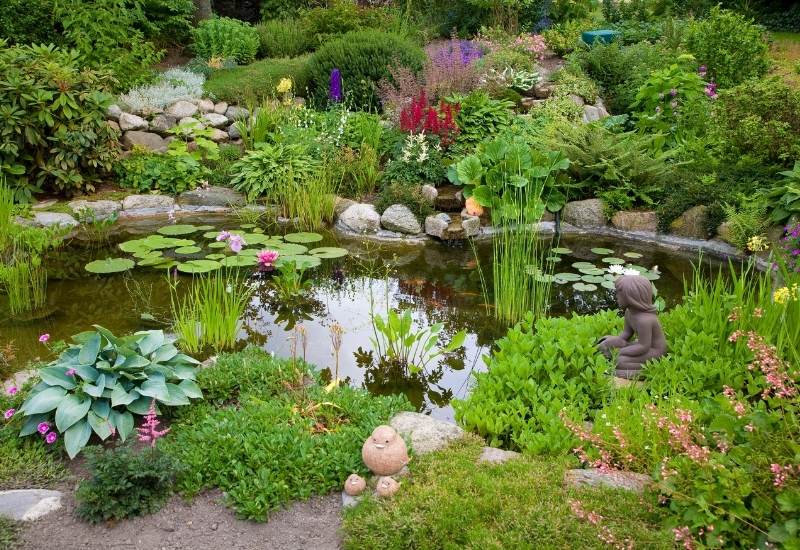
Fill your pond or other water feature with one or more of these aquatic plants to create your own thriving mini garden pond.
What is a pond without beautiful water plants? Even a small water feature, a fountain and an aquarium look far better with beautiful leaves and flowers in them. But aquatic plants are a group on their own different from “land plants”.
They have a special beauty, that of bogs, lakes, river banks and garden ponds, but you need to know them well. Beyond their aesthetic value, water plants have many functions, decorative, oxygenating, and for the whole environment of your pond or water feature.
So, whether it’s a fountain, waterfall or a pond planted indoors or in your backyard choosing the right water plantsis the first step to create thriving eco-system in your water garden.
There are five main types of aquatic plants every water garden should include:
With so many pond plants to choose from, trying to replicate a soothing, beautiful and functional water garden can be daunting. That’s why in this article I’ll explain a whole underwater and surface world of plants to you. You will find the best aquatic plants for your pond or water feature for each group or category, as well as key principles of growing water plants.
We’ll see them all soon, but first do you know why you should grow plants in your pond? I’m going to tell you right now!
What Are Water Plants?
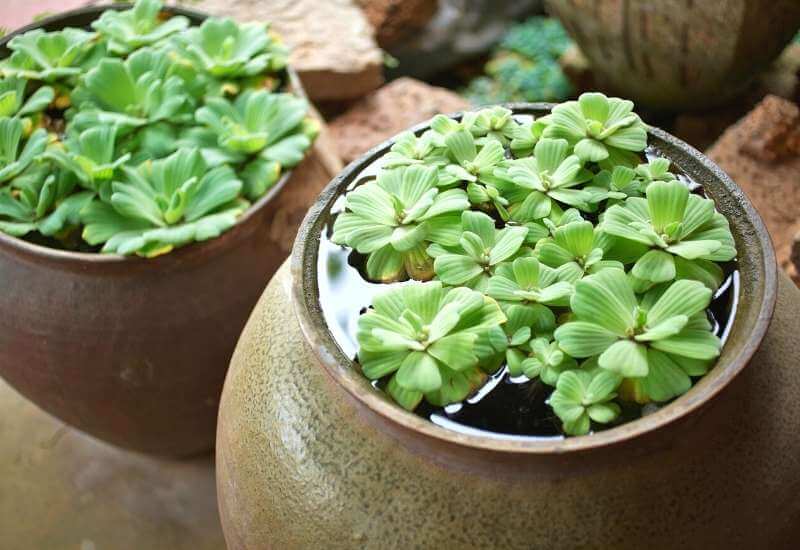
Water plants, a.k.a. aquatic plants for scientists, are plants that mainly grow in water. Some are more suitable as garden plants, others as aquarium plants and some are not cultivated at all…Basically any plant that likes to grow with at least its “feet”, its roots in a waterlogged environment or directly in water is called a “water plant”. Some, like conntail, grow completely in water, some have parts of the aerial body over the water, and some have only their roots in water.
In gardening terms, water plants are those you grow in or even around a pond. On the banks of the pond, in fact, the plants may end up having their roots under the water level, so you need specific plants that can survive in these conditions.
Eve bog plants are classed as water plants. That is because in a bog, water covers the roots, even if they hold on to soil or organic matter.
Finally, when we say water plants, we mean only that grow naturally in water. Hydroponic plants are not water plants.
Why Should You Add Water Plants to Your Pond?
If you have a pond or another water source or feature in your garden, or indoors, water plants are very useful. To start with, they are beautiful and they make your water feature look natural. But there are other advantages of growing water plants:
As you can see, plants are super hard workers even if they don’t look like it. They are rally your best friends, and there are plants for many functions (including purifying water, as they do at Highgrove,
Prince Charles’s organic garden, where all used water is purified in ponds, with plants!) But first you need to know a few basic tricks.
Care And Maintenance Of Your Water Garden Or Pond Plants
Of course growing plants in water is not the same as growing them in the soil. There are different basic chores and activities, and here they are for you.
These are necessary steps, but what matters most is that you choose the best plants for the best environment, and this is what we are going to see next.
16 Best Pond Plants To Grow In Your Water Garden
Here are 16 aquatic plants that are must-haves for a indoor container water garden or small backyard pond.
Best Bog Plants For Ponds
Bog plants are water plants, even if many people don’t realize it. You may have a boggy area and wonder what to do with it. There is no reason why, if your garden has wetland, it should not have stunning flowers and even become productive! Bog areas also form near ponds, rivers and other natural sources of water, so, if this is your case, be aware that you can literally stun your visitors, if you see this as an opportunity and not a problem. Do you want some examples of plants you can grow on bogland?
1: Trumpet Pitcher Plant (Sarracenia Spp.)
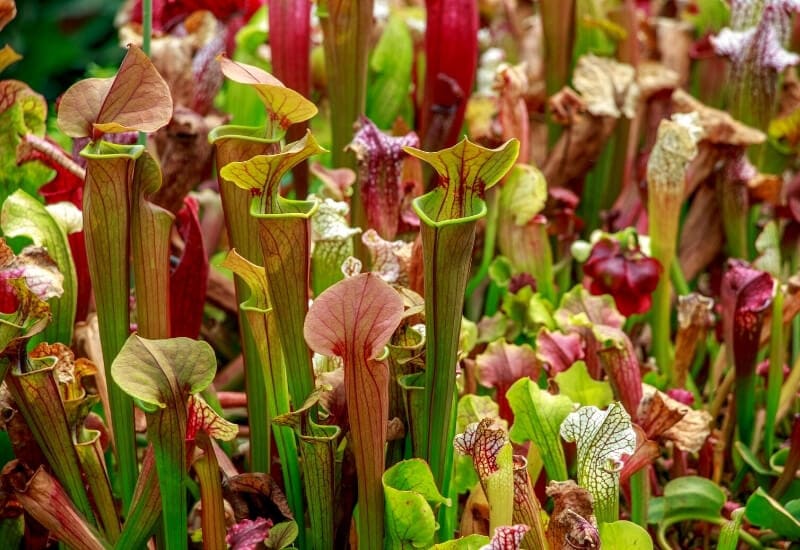
Carnivorous trumpet pitcher plants love growing in boggy soil of the edges of your garden pond. They are stunningly exotic and “weird looking”. But they are also very sculptural thanks to their pitcher shape and very smooth, shiny surface.
There are about 11 species and they come in many bright colors, yellow, red, green and purple, with many decorative patterns.If the foliage is stunning and will look like some exotic vase in that forgotten corner of your garden, the flowers are stunning and tropical looking too, of many colors and resembling some “tropical version of columbine”.
2: Giant Brazilian Rhubarb (Gunnera Manicata)
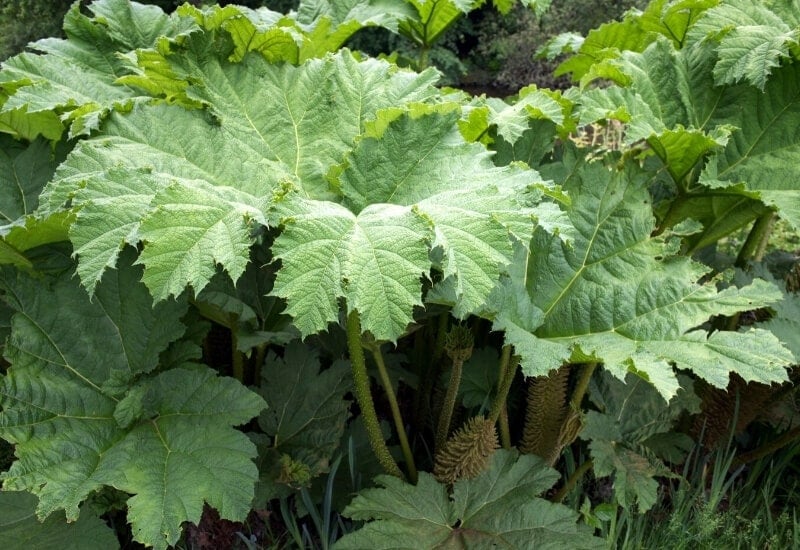
If you have a large boggy area and you don’t know how to use it, grow giant Brazilian rhubarb. This massive aquatic pond plant has massive palmate leaves that look a bit like those of zucchini, but, well, they are massive! Each leaf can reach 11 feet (3.3 meters) across! This plant has an exotic and even prehistoric look and a very, very strong presence!The added bonus is that you can eat the young stems, and that is why it is called “Brazilian rhubarb”. And it will also grace you with very unusual and – you guessed – massive blooms that look like brown – reddish squirrel tails if the conditions are right.
Marginal Aquatic Plants
Water plants don’t just grow fully in the water. Marginal plants are type the aquatic plants that grow at its margins, on the banks of your pond, maybe only with the roots in the water and most of the aerial part of the plant dry in the Sun… In fact a marginal plant is technically any plant that can live with up to 12” (30 cm) above its crown in the water.These are very useful for decorative purposes, because they hide the banks of the pond (which are often quite unsightly), and they offer a transition from land to water.
What is more, their roots hold the banks of your pond in place and prevent them from sliding into the water. Finally, they provide good shelter for frogs, and similar little animals. Did I say that they are beautiful? If you don’t trust me, read on…
3: Aquatic Iris (Iris Spp.)
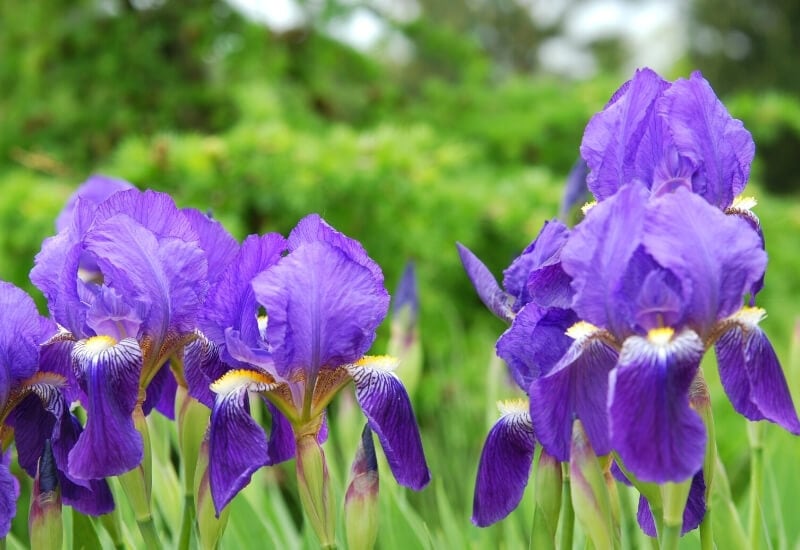
You must have seen aquatic iris plants blossoming on the banks of ponds in large gardens. This is in fact one of the most popular marginal plants ever. The foliage is beautiful and quite architectural.
But then again we all know this flower for its showy, original looking flowers of the brightest colors, from white to yellow, orange red, blue purple… And many combinations too.Just imagine the colors this flower can bring to the sides of your pond or stream, especially if you grow it in small clumps!
4: Rush (Juncus Spp.)
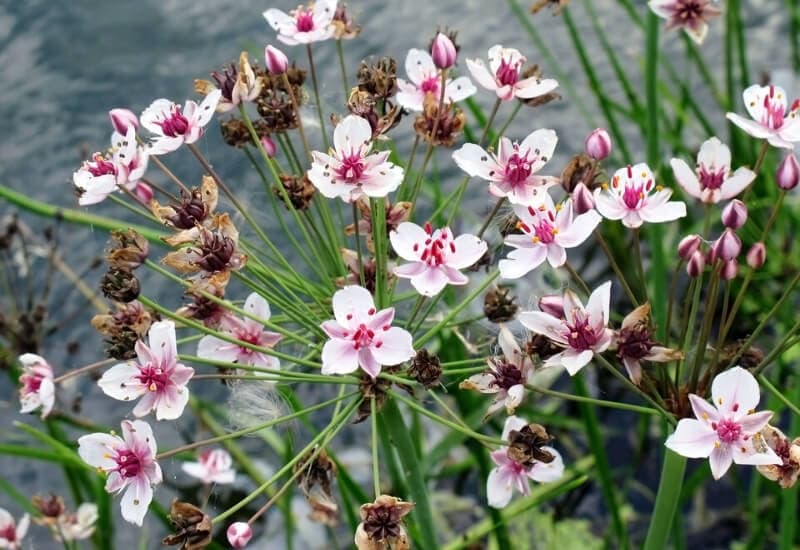
Rush is maybe the plant we associate with lake and river banks most often. In fact we imagine it with some water birds nesting in it… It typically has long and thin upright stems and leaves,
but there is also curly rush and dwarf rush if you want a little variety. And don’t forget variegated rush, which has two colors, cream and green!Imagine your pond revealing itself to your visitors from behind a green “ruch curtain”… That is an effect you really can’t miss if you can afford it!
5: Canna Lily (Canna Indica)
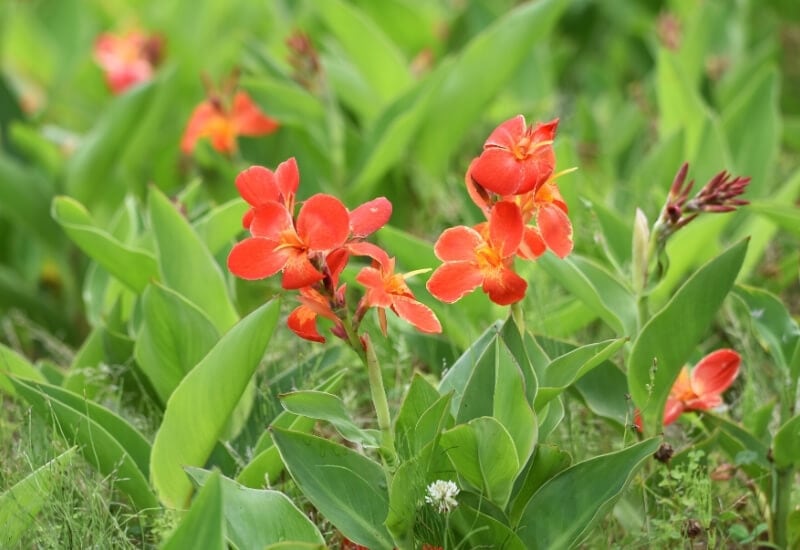
Canna lily loves keeping its feet wet, and it will add wonderful foliage and those striking, red, yellow or orange flowers it is famous for to your garden pond.
The foliage of this exotic plants just shouts “tropical!” too. They are large, shiny and they can be green, red or purple, or a mix of colors.Growing canna lily is always a pleasure, and if you have a pond, it is the best place for this fantastic flower to show off all its tropical beauty.
6: Cattail (Typha Spp.)
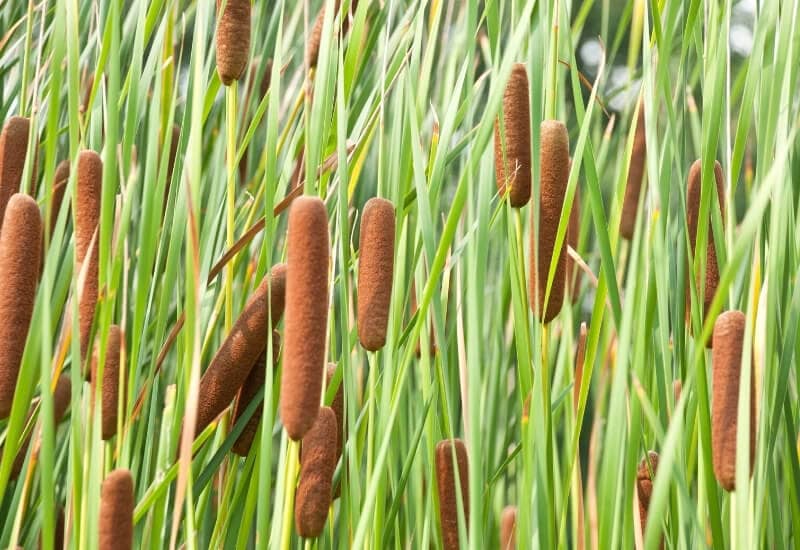
Cattail or bulrush is another classical aquatic pond plant. It is famous for its sausage shaped inflorescence that looks like a fluffy tail, growing above upright, long and blade like leaves.
It forms large “colonies” at the sides of lakes and ponds, and there are 30 different species you can choose from.The “tails” will add color and texture to your pond planting, and they will last for many weeks. And you can eat the shoots of cattail too – the best way to contain its spreading, in fact!
Deep Water Aquatic Plants
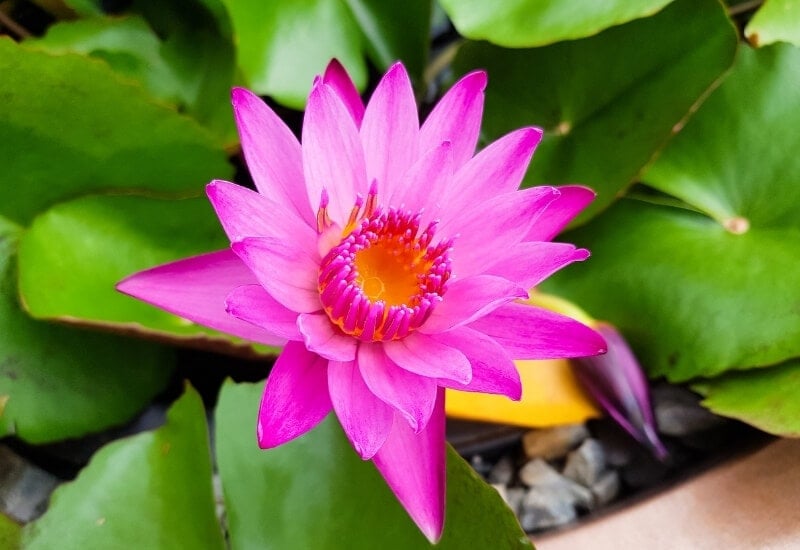
Welcome to the centerstage of your pond or water feature: where we grow deep water plants. These are plants that mainly grow in the water, leaving only the leaves and flowers floating on or just above the water.
Their roots (often a rhizome) are firm under the bed of the pond, but they stretch all the way to keep the foliage on the surface, with long stems.Deep water plants are really excellent to protect wildlife inside the pond, to offer “diving boards” for frogs, to keep the water cool in summer and, above all, they are just beautiful!
7: Water Lily (Nymphaea Spp. And Others In The Nymphaeaceae Family)
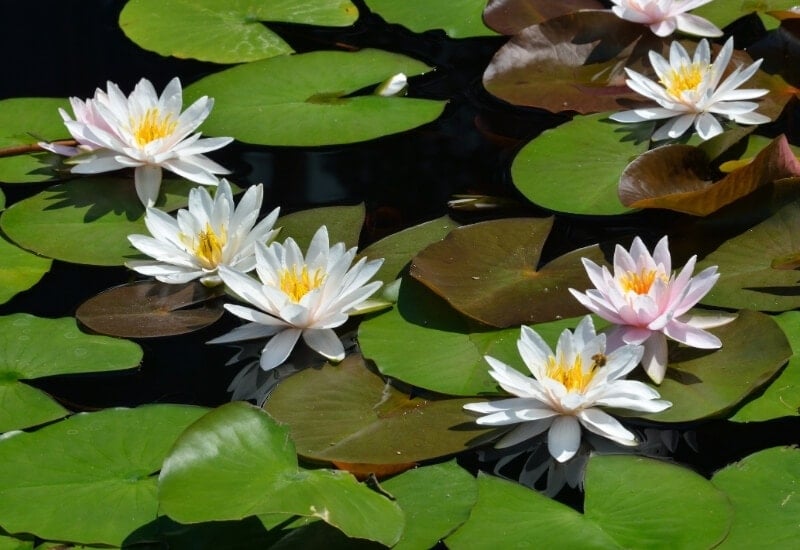
Finally the “queen of ponds”, water lily. These lovely water plants are just pure magic with their round leaved floating on the water surface and those star shaped flowers, that can be white, yellow, pink, red, orange, blue and purple!
There are also many sizes, from dwarf varieties to the Victoria water lily (Victoria amazonica), with leaves that reach 10 feet in diameter (3 meters). Like small boats.Let’s say it as it is: a decorative pond is not finished until you grow some water lilies in it. So, choose from one of the many varieties and plant it. (The rhizome can go in a basket at the bottom of the pond, by the way).
8: Water Hawthorn (Apnogeton Dystachyum)
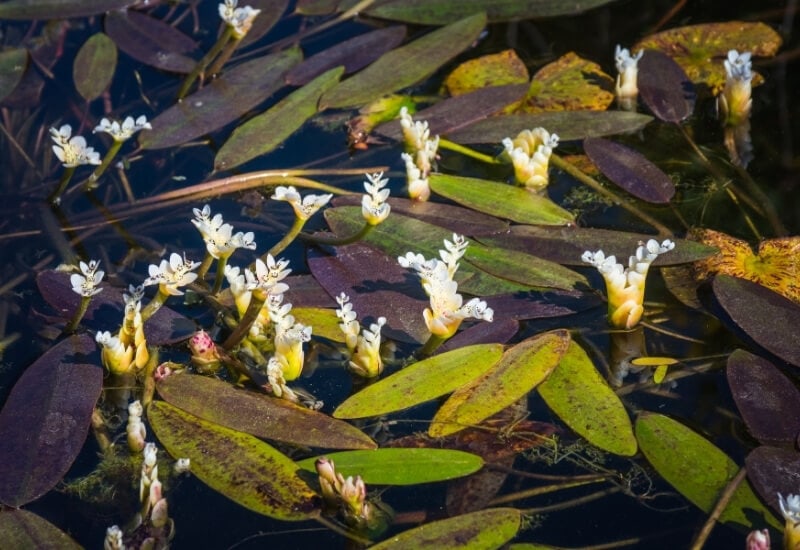
This South African deep water plant is original, exotic and elegant. It has oval leaves that rest on the water surface like little boats. The flowers, instead hover just above them, and they look very unusual.
They are white with dark purple pistils, and sweet smelling, they come on a white stem with what looks like butterfly wings, or rabbit ears in an upright row.This is a delicate flower that brings a touch of originality but also of great tranquility to your pond. It will show you have great taste and knowledge when it comes to water plants.
9: Lotus (Nelumbo Spp.)
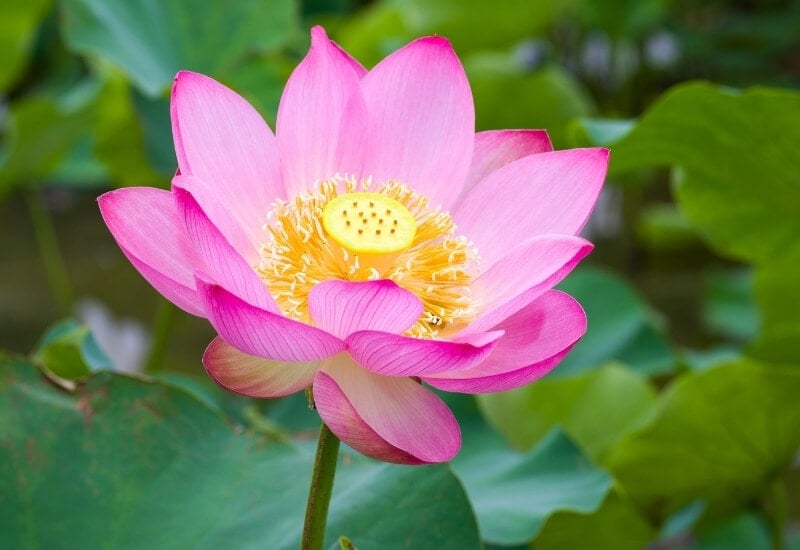
Lotus is the most mystical of all deep water plants love to thrive in your garden pond. It has an iconic shape, with some of the most delicate and bright coloring ever and original pod in the middle.
The range of shades is huge, and the leaves are beautiful, rounded and above water. Lotus is in fact real classic. Some come from Asia, like Indian lotus (Nelumbo nucifera) but Nelumbo lutea is from the Caribbean and North America.Lotus will bring peace, tranquility and touch of oriental beauty and philosophy to your water pond. It’s not a chance that it is the symbol of India and Thailand, and it is actually called “sacred lotus”.
10: Arrowhead (Sagittaria Spp)
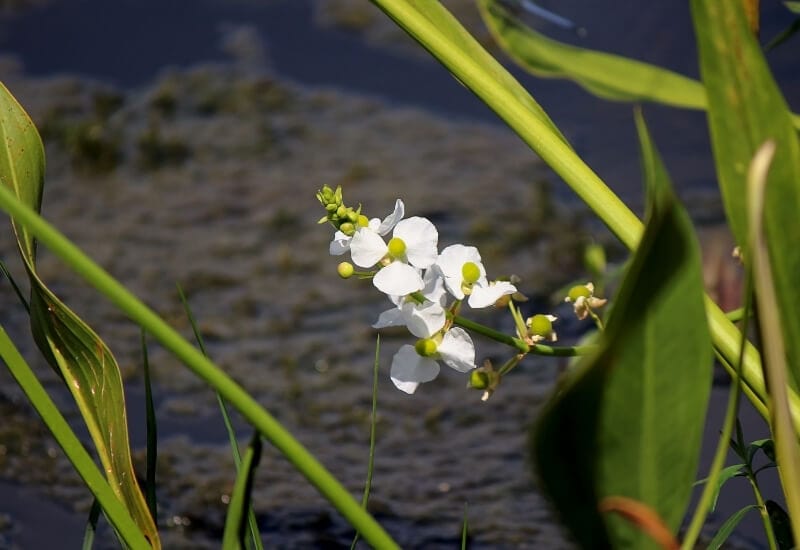
Arrowhead is a very striking deep water plant indeed. Its leaves are arrow shaped, which gives a dynamic touch to your pond, as they grow above the surface. They point up, so it adds a lot of depth to the foliage of your pond.
The flowers are white – or yellow in some species – and sweet looking, and they come on racemes, each showing off at some distance from the other.It is a perfect plant for ponds in most settings, informal and formal, and there are 30 different species you can choose from!
11: Pond Lily (Nuphar Spp.)
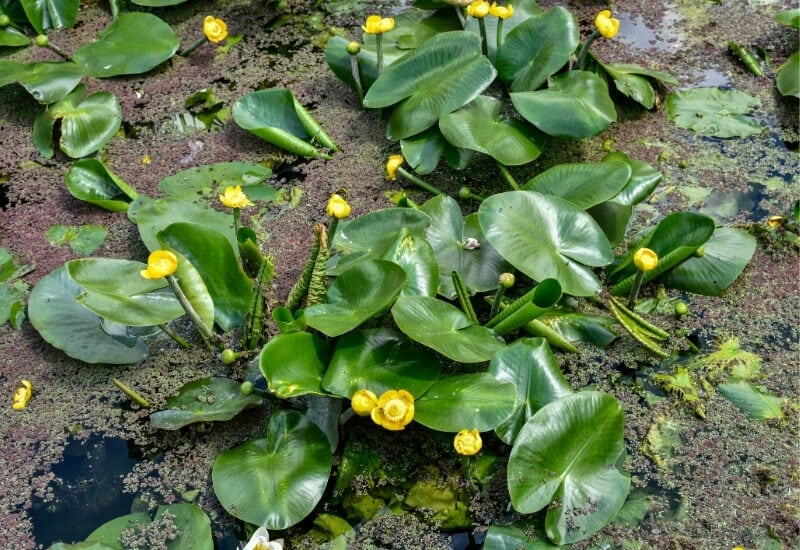
Pond lily is a type of water lily, but less showy as a flowering plant. It has similar, round leaves to those of water lilies, green or sometimes purple.
The flowers, however, are cupped, with 5 rounded petals, unlike water lilies. They are of a strong canary to saffron yellow color, and they appear as isolated heads above the water.Not as showy as more common water lilies, it is still very beautiful and it is perfect if you want to achieve a natural and temperate look in your garden and pond. And the blooms last for months!
Free Floating Aquatic Plants
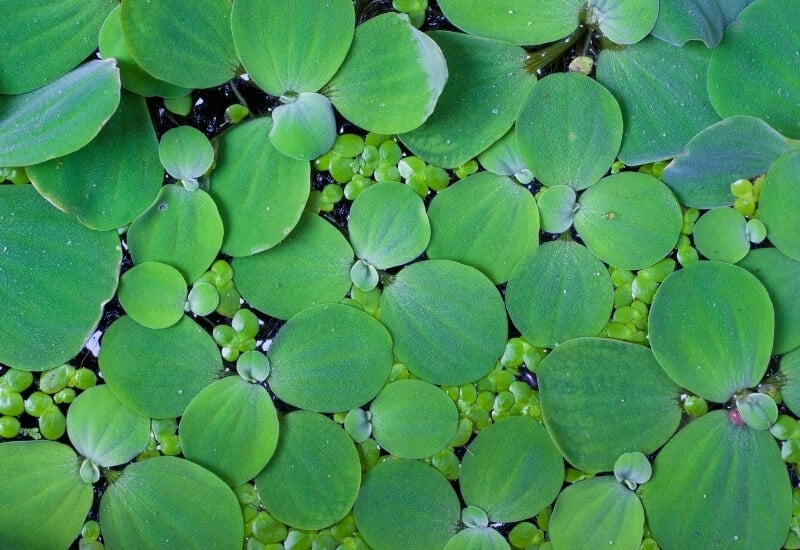
Free floating plants are really playful. Basically they hang their roots in the water and in most cases, they use their leaves to float above water.
These are not anchored to the soil, to the bed of your pond. As a consequence, they move around, floating freely.They are usually very good at filtering and purifying water, and they are very beautiful and strange indeed. I would never do without one (or more) in my garden pond!
12: Water Hyacinth (Pontederia Crassipes)
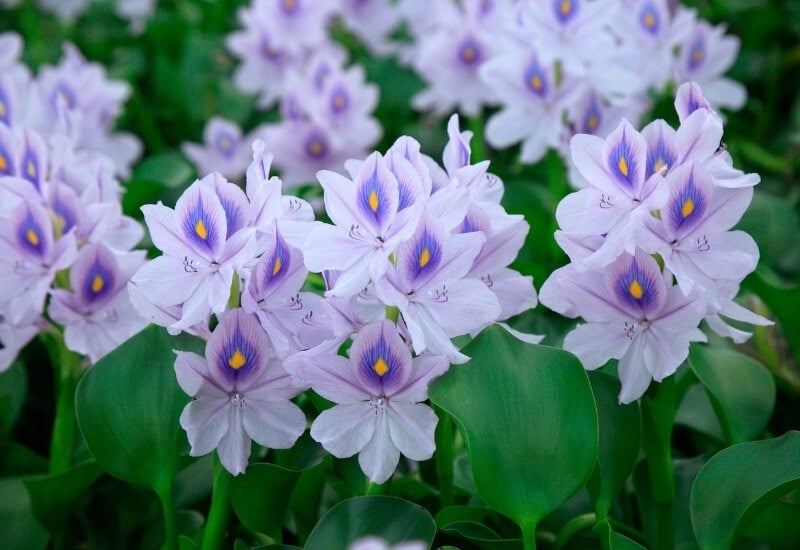
Water hyacinth is a wonderful free floating water plant. The leaves are elliptical, partly curled, very fleshy and emerald green. They will come just above the water and point up. The flowers are striking.
They come in clusters like hyacinths, but of only a few, large blooms of 6 petals. They are light magenta apart from the top one, which has a large yellow dot, surrounded by a violet blue patch within the magenta petal.You can add texture to your pond’s foliage and great vibrancy to its flowers, and at the same time bring an extremely exotic touch to it if you grow water hyacinths. It also propagates fast, so you’ll have to thin it down regularly.
13: Water Lettuce (Pistia Spp.)
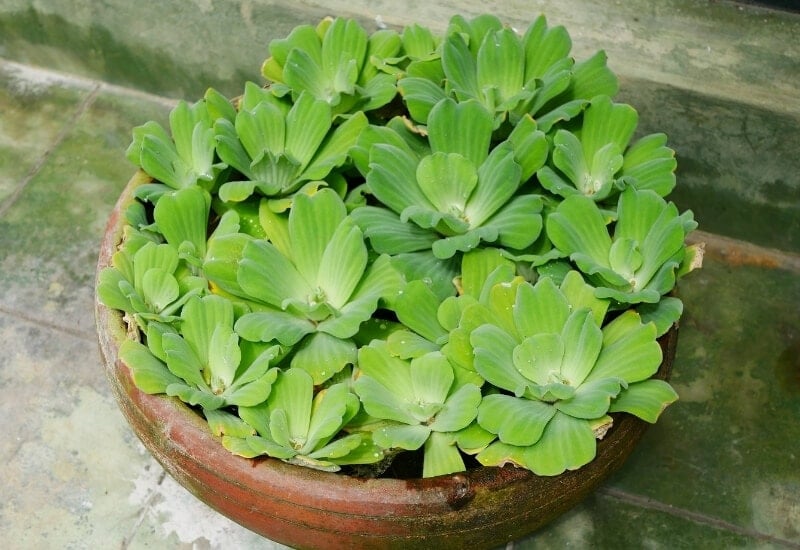
Water lettuce is a very playful free floating water plant that you can add to your indoor container water garden and small backyard pond! It looks like lettuce, in fact, with green, rounded and fresh looking leaves in a rosette.
The fact is that they look like cups floating on the surface of your pond! The leaves are also beautifully veined, with lines that run along the length of the decorative leaves. Now, close your eyes and imagine your pond with floating “lettuce heads” all over it; wouldn’t your children just love it? This plant too needs thinning quite regularly because it propagates fast.
14: Water Lentils (Lemnoideae Subfamily; Four Genera In It)
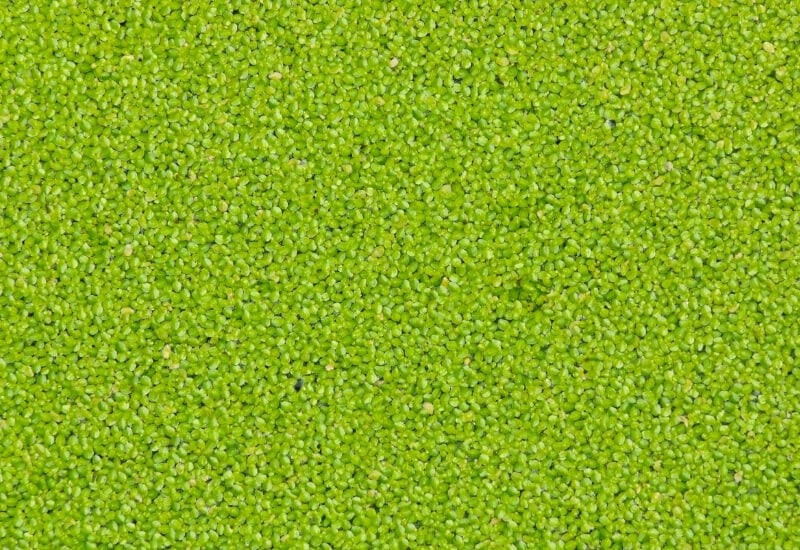
We all love water lentils! Also known as duckweeds, they are tiny round leaves that grow on the surface of the water and fill it with green…
They are juts the most playful of all water plants, and given their little size, they need fresh, clean but still water. Children love playing with them too. There are many different species, in fact four full genera of water lentils. Just drop a few in your pond and they will soon propagate and become the “glittering backdrop” of all your bigger water plants. Remember to thin them down too; they can easily cover the whole surface in a matter of weeks.
Submerged Water Plants
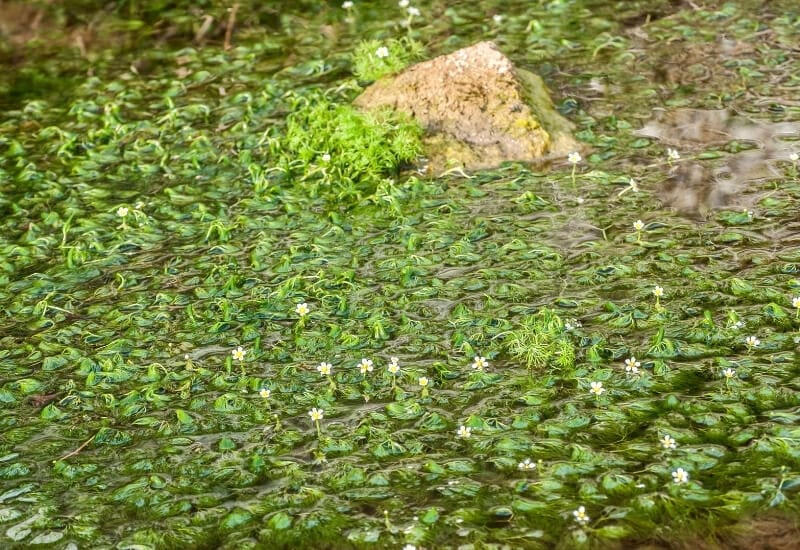
There are also plants that live totally under the water. If you have ever seen an aquarium, you will know that under the water surface, there is a whole world, or a “garden” that we often miss… These are called submerged water plants or oxygenating pond plants.But they are not just useful for your aquarium; they are actually great for ponds too. In fact they help life within the water and they are excellent at oxygenating the water! There are many, but here are so e great ones!
15: Coontail (Ceratophyllum Demersum)
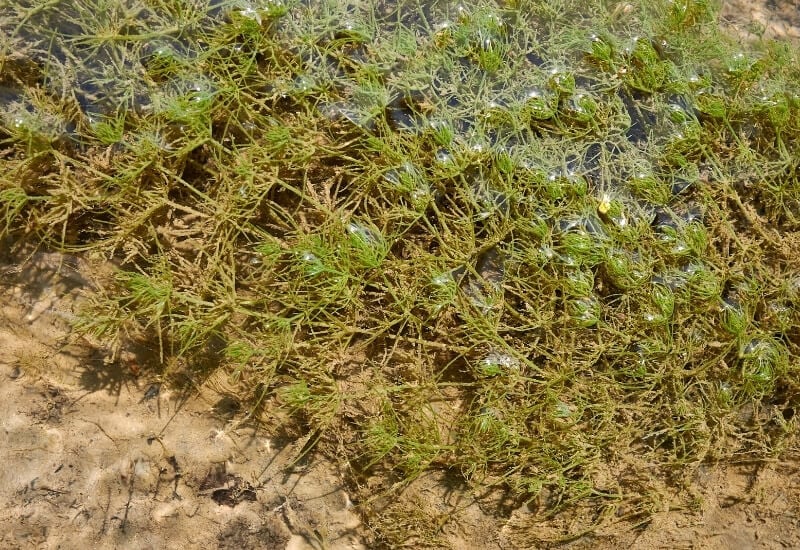
Coontail is a favorite submerged oxygenating pond plant because it looks light, airy and feathery. It is of a very rich jade green color, and it looks like many tails made up of “pine needles” stacked together. However, to me it looks more like green feathers moving softly in the water.It provides an excellent shelter for small creatures, so it helps maintain the ecosystem of your pond, as bigger animals (newts, frogs and fish) will need a constant source of food.
16: Water Wisteria (Hygrophila Difformis)
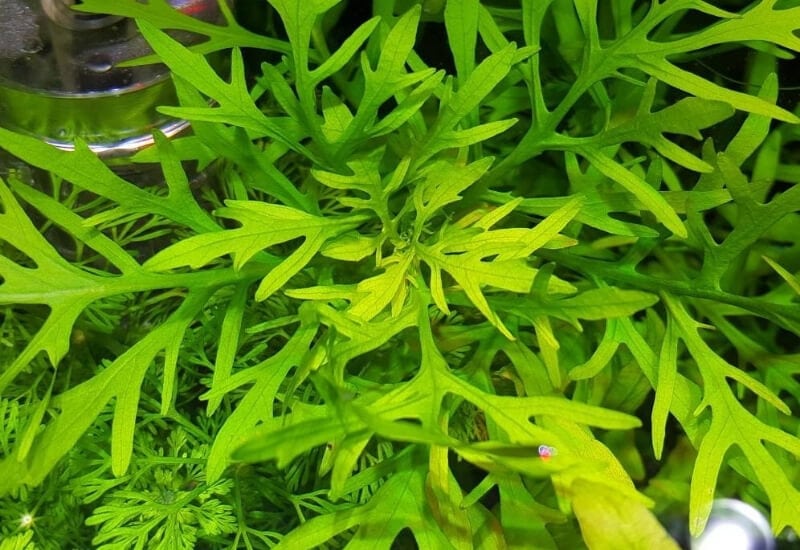
A little gem which is becoming popular in aquariums and is easy to grow is water wisteria. This aquatic pond plant has lovely segmented foliage, and it looks a bit like mugwort, if you want an overground comparison. This submerged water plant is good at oxygenating the water and it too provides shelter for little creatures… Fish like swimming between its leaves, and they look great when they do that from above water.One of the reasons why it is popular is that it is very easy to grow. So, it’s a great choice if you want a low maintenance, but still professional looking, garden pond.
But this is a strange plant, because if the water is not deep enough, it can even emerge… But if it emerges, the leaves are totally different, oval shaped…
A World Of Water, Plants And Flowers!
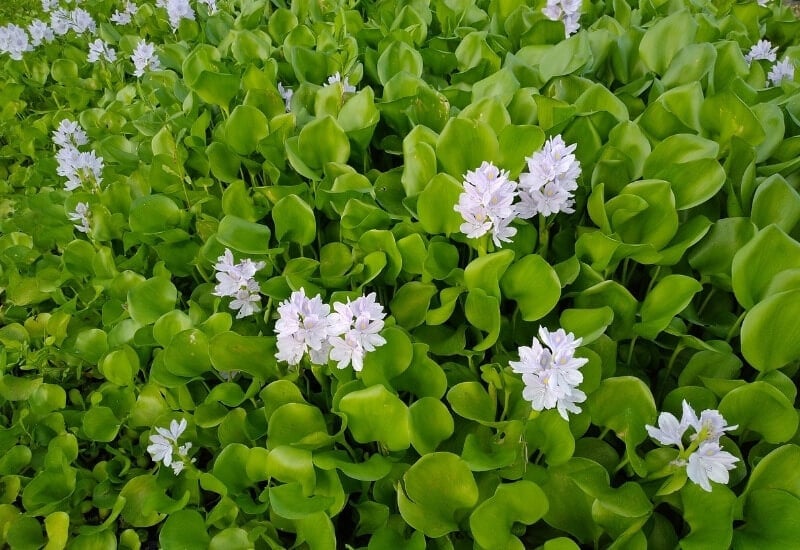
Did you expect that you could grow so many and so diverse plants in a pond? Water plants are a bit of a “world of their own”.
They are not as well known as land plants, and maybe you did not expect that there would be bog plants, marginal plants, submerged plants, deep water plants and even floating plants! But now you know, so you know how to play with all the different “zones” and “dimensions” of your pond, river or water feature, and now you know that that “pool of water” can turn into a watery paradise full of plants of all sorts!

Written By
Amber Noyes
Amber Noyes was born and raised in a suburban California town, San Mateo. She holds a master’s degree in horticulture from the University of California as well as a BS in Biology from the University of San Francisco. With experience working on an organic farm, water conservation research, farmers’ markets, and plant nursery, she understands what makes plants thrive and how we can better understand the connection between microclimate and plant health. When she’s not on the land, Amber loves informing people of new ideas/things related to gardening, especially organic gardening, houseplants, and growing plants in a small space.

Ask which plants will grow best in alkaline water? No amount of acidifier helps the ph in our pond.